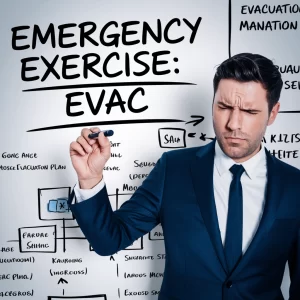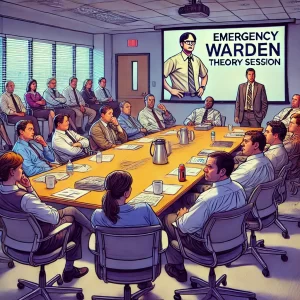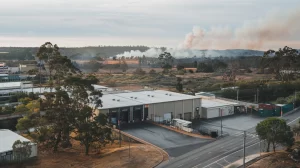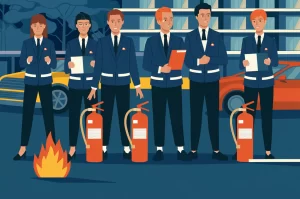In a large building, chaos during an emergency can be a real risk. Imagine trying to coordinate hundreds of people to evacuate all at once, with no clear leadership in each area. That’s where area wardens come in. They’re like the captains of their own little ships, ensuring their specific zones are organized and safe during an emergency.
Area wardens play a critical role in workplace safety. They’re the front line when it comes to evacuating employees and making sure everything runs smoothly during an emergency. Their job is to be prepared, act fast, and take control when things get chaotic. In this guide, we’ll cover everything you need to know about being an area warden, from daily responsibilities to what to do in the heat of the moment.
What Is an Area Warden?
An area warden is responsible for leading a specific zone or floor of a building during an emergency. Think of them as the person in charge of that part of the building when things go wrong—whether it’s a fire, medical emergency, or an evacuation due to a security threat.
Area wardens are crucial in larger buildings because they break up the overall responsibility of evacuating everyone. Instead of a single person trying to manage the entire building, area wardens ensure that specific sections are handled efficiently. They coordinate directly with the Chief Warden, who oversees the entire emergency response.
But it’s not just about evacuations. Area wardens also keep a lookout for hazards in their zones, ensuring that everything is running smoothly in the lead-up to an emergency. It’s about preparedness and awareness, long before the alarm sounds.
Key Responsibilities of an Area Warden
The role of an area warden comes with several critical responsibilities that ensure their area is safe before, during, and after an emergency. Here are some of the key tasks they handle:
Monitoring for Hazards: Area wardens are responsible for identifying potential safety risks, like blocked exits or malfunctioning alarms, and reporting them to the Chief Warden or management.
- Emergency Equipment Checks: They make sure fire extinguishers, alarms, and other safety equipment are present and functional in their designated areas.
- Directing Evacuations: In an emergency, area wardens guide employees out of the building safely and quickly. They ensure everyone follows the correct routes and heads to the right assembly points.
- Communication: Area wardens serve as a crucial communication link between the employees in their area and the Chief Warden. They report incidents, pass along important information, and help keep everyone calm.
- Assisting Those in Need: If anyone in their area has mobility issues or requires special assistance, it’s the area warden’s job to make sure they get the help they need to evacuate safely.
Preparing for Emergencies as an Area Warden
Preparation is everything. For an area warden, this means staying on top of safety protocols and ensuring the area is always ready for an emergency. Here’s what you can do to prepare:
- Regular Inspections: Take a walk around your area regularly to check exits, alarms, and emergency lights. Ensure there’s nothing blocking escape routes.
- Know the Layout: Make sure you know your floor plan inside and out. You should know all the exits, safe areas, and where emergency equipment is located. In an emergency, you won’t have time to figure things out—you need to know instantly.
- Lead Drills: Organize and lead emergency drills for your area. This helps your colleagues get familiar with the process and ensures that everyone knows what to do during a real emergency.
- Stay Trained: Participate in regular training sessions, and make sure your skills are up-to-date. The more you know, the better you can lead in a crisis.
What to Do During an Emergency
When an emergency strikes, your job as an area warden is to lead by example. Here’s a step-by-step guide to what you should do:
- Respond to the Alarm: Whether it’s a fire alarm, medical emergency, or something else, act quickly. If you’re the first to spot the problem, sound the alarm immediately.
- Direct Evacuation: Calmly guide employees towards the nearest exits. Make sure everyone sticks to the designated evacuation routes and heads to the assigned assembly point.
- Check for Stragglers: Take a quick sweep through restrooms, storerooms, and other confined areas to ensure no one is left behind.
- Report to the Chief Warden: Once your area is clear, relay the status of your zone to the Chief Warden. Let them know if anyone is missing or if there were any issues.
- Remain Calm: This is crucial. If you panic, others will panic too. Stay calm, give clear instructions, and ensure that everyone stays focused on getting to safety.
After the Emergency: Debrief and Reporting
Once the emergency is over, your job isn’t done. It’s time to review what happened and see if anything can be improved.
- Debriefing: Meet with the Chief Warden and other area wardens to discuss how the evacuation went. Did everything go smoothly? Were there any hiccups?
- Report Issues: If you noticed anything during the drill or emergency—like an exit being blocked or someone struggling to follow instructions—report it. This helps the team improve the emergency procedures for next time.
- Document Everything: Write up a brief report about what happened. This documentation can be invaluable for future training and planning.
- -Suggest Improvements: If you have ideas about how things could be done better next time, don’t be afraid to share them. Your feedback is key to improving safety protocols.
Conclusion: Why Area Wardens Are Critical
Area wardens are the backbone of any successful workplace emergency plan. Without them, managing large groups of people during a crisis would be chaotic and dangerous. By taking responsibility for specific zones, they ensure that every part of a building is evacuated safely and efficiently.
But being an area warden isn’t just about reacting to emergencies—it’s about being prepared long before anything happens. Regular training, drills, and inspections are all part of the job, and they make a huge difference when it matters most.






